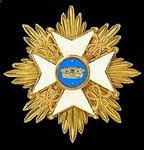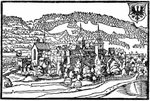
 First raised 1733. 8 companies in 4 squadrons 1756, theoretical strength 762. Chef: to 1758, Prinz Karl von Sachsen, after 1758 Duke of Kurland. Commanders: 1745-1757 Leutnant-General Nostitz, mortally wounded Leuthen; replaced by Colonel von Benkendorf. The chevaulegers regiments were mostly mounted on cheaper Polish horses than the cuirassiers and the Rutowski Dragoons, who had the more expensive German horses.
First raised 1733. 8 companies in 4 squadrons 1756, theoretical strength 762. Chef: to 1758, Prinz Karl von Sachsen, after 1758 Duke of Kurland. Commanders: 1745-1757 Leutnant-General Nostitz, mortally wounded Leuthen; replaced by Colonel von Benkendorf. The chevaulegers regiments were mostly mounted on cheaper Polish horses than the cuirassiers and the Rutowski Dragoons, who had the more expensive German horses.
3 of the chevaulegers regiments were stationed in Poland when much of the Saxon army surrendered at Pirna in 1756 and so avoided the capture and forced enlistment by the Prussians which most of the army suffered. From 1757 those 3 chevaulegers regiments served with the Austrians. All 3 were at Kolin 18th June 1757, where, along with Austrian cavalry and infantry, they delivered the coup de grace to the Prussian army late in the day, the first major defeat the Prussians had suffered. As they hacked into the Prussian infantry the Saxon battle cry was "Dies ist für Striegau!" ["This is for Striegau!", the Saxon name for their defeat at Hohenfriedberg 1745]. The Saxons had much to avenge, as Frederick bore a grudge against all things Saxon that manifested itself in all manner of brutalities. Prinz Karl were at Moys, September 1757, when Winterfeldt's Prussian detachment was crushed and Winterfeldt, Frederick's closest confederate, was killed (possibly shot in the back by his own troops). They were also at the Austrian victory at Breslau, November 22nd 1757, as part of Nadasdy's right wing. At Leuthen December 5th 1757 the Saxon chevaulegers regiments were savagely mauled. Initially they were in advance of the main Austrian army at Borne, where Frederick's advance guard beat them and pushed them back on the Austrian army's main lines. They were then sent to the left flank, where they were involved in the main Prussian flank attack that routed the Austrian and allied army. Nostitz, their commander and "a first class officer" (Duffy, "Prussia's Glory"), was mortally wounded and out of a total of around 1200 men in the 3 chevaulegers regiments, 479 were killed, wounded or captured. Prinz Karl alone lost 214, probably more than 50% of the regiment. The 3 chevaulegers regiments continued to serve with the Austrian army for the rest of the war; Prinz Karl particularly distinguished themselves at the Relief of Olmütz June-July 1758, when a large Prussian convoy was destroyed forcing Frederick to abandon the siege with heavy losses, and at the battle of Freiberg 29th October 1762.
Monday, 29 June 2009
Trooper of the Saxon Chevauleger Regiment Prinz Karl
Posted by
David Morfitt
at
Monday, June 29, 2009
![]()
Subscribe to:
Post Comments (Atom)


















What a glorious history! When I get a chance, I will add these guys to my Saxon forces...
ReplyDeleteNice work as usual! Thanks for the history, too! I confess I don't know a whole lot about the period so every little bit helps.
ReplyDeleteMy favourite, and probably most apposite of "Old Fritz's" quotes...
ReplyDelete"Saxony is like an empty bag of flour. No matter how often you beat it, something always comes out!"
How very true.
Thanks, FB. More Saxons to come - once I can puzzle my way through some German text!
ReplyDeleteDavid.
Hi Steve,
ReplyDeleteOld Fritz really had it in for Saxony, didn't he? Even Christopher Duffy seems to agree that a distinctly shady and unpleasant experience of Fritz's youth may have been the cause of it - but we'll probably never know for certain. I'm sure he must have been an impossible man with whom to have any dealings - fascinating but repellent...
David.
Hi Bill,
ReplyDeleteOh yes, you must have some Saxon chevaulegers! :-) Any enemy of that wicked fellow Frederick needs Saxons hot for vengeance...
Thanks for commenting.
All the best,
David.